Honda Pilot: Maintenance Under the Hood
- Maintenance Items Under the Hood
- Engine Compartment Cover
- Oil Check
- Changing the Engine Oil and Oil Filter
- Engine Coolant
- Brake Fluid
Maintenance Items Under the Hood

- Engine Oil Fill Cap
- Engine Oil Dipstick (Orange)
- Washer Fluid
- Radiator Cap
- Battery
- Brake Fluid (Black Cap)
- Engine Coolant Reserve Tank
Opening the Hood
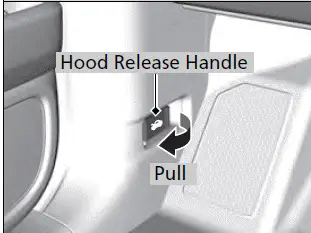
1. Park the vehicle on a level surface, and set the parking brake.
2. Pull the hood release handle under the driver's side lower corner of the dashboard.
- The hood will pop up slightly.

3. Push the hood latch lever (located under the front edge of the hood on the driver's side) to the side and raise the hood. Once you have raised the hood slightly, you can release the lever.
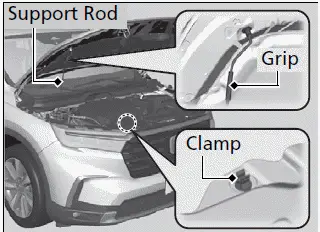
4. Remove the support rod from the clamp using the grip. Mount the support rod in the hood.
When closing, remove the support rod and stow it in the clamp, then gently lower the hood. Remove your hand at a height of approximately 12 inches (30 cm) and let the hood close.
NOTICE
Do not open the hood when the wiper arms are raised. The hood will strike the wipers, resulting in possible damage to the hood and/or the wipers.
NOTICE
Do not press the engine cover forcibly. This may damage the engine cover and component parts.
When closing the hood, check that both right and left latches are securely latched.
If the hood latch lever moves stiffly, or if you can open the hood without lifting the lever, the latch mechanism should be cleaned and lubricated.
Do not open the hood while the Auto Idle Stop function is activated.
NOTICE
If a warning message for "hood open" is displayed, either right, left, or both hood locks are not correctly locked in place.
If they are incorrectly locked in place, the hood may open while driving.
Immediately stop in a safe place and close the hood by pressing down on the front of the hood until both locks are latched and the warning disappears.
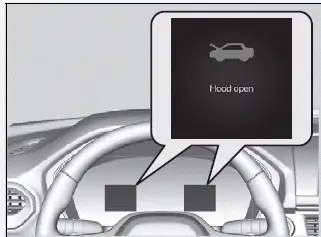
Engine Compartment Cover
The engine compartment components in your 2023 Honda Pilot are
protected by a cover. You may need to remove this cover to perform certain
maintenance tasks. To do so, simply pull up on the engine compartment cover and
detach it from the retaining clips.
Once the cover is removed, ensure you place it in a safe location to avoid any
damage. After completing the necessary maintenance, reattach the cover by
aligning it with the retaining clips and pressing it down firmly until it is
securely in place. Always ensure the cover is properly secured before driving to
protect the engine components from dirt and debris.
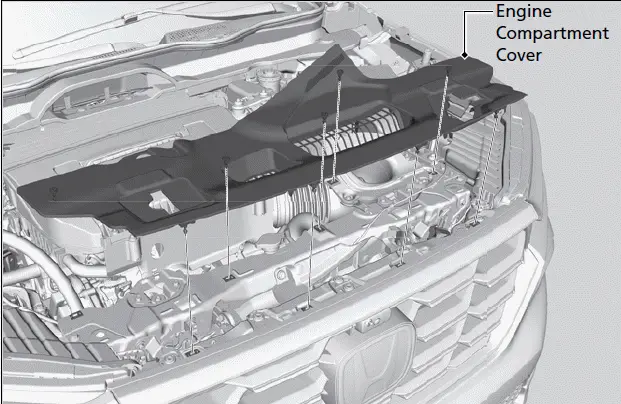
Recommended Engine Oil
Use a genuine engine oil or another commercial engine oil of suitable type and viscosity (for the ambient temperature) as shown in the image that follows.
Oil is a major contributor to your engine's performance and longevity. If you drive the vehicle with insufficient or deteriorated oil, the engine may fail or be damaged.
Genuine Engine Oil
- Honda Genuine Motor Oil
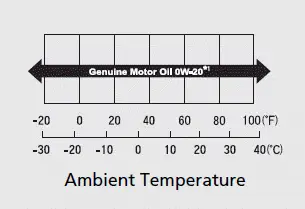
Commercial Engine Oil
- API service SN or higher grade
- API Certification Mark "Starburst"

*1:Formulated to improve fuel economy.
Engine Oil Additives
Your vehicle does not require oil additives. In fact, they may adversely affect the engine performance and durability.
The following seal indicates the oil is energy conserving and that it meets the American Petroleum Institute's latest requirements.
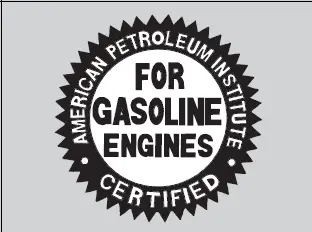
Synthetic oil
You may also use synthetic motor oil if it is labeled with the API Certification Seal and is the specified viscosity grade.
Oil Check
We recommend checking the engine oil level of your 2023 Honda Pilot
every time you refuel. Follow these steps for an accurate reading:
1. Park the vehicle on level ground.
2. Turn off the engine and wait approximately three minutes.
3. After the wait, check the oil level.
Regularly monitoring the engine oil ensures your vehicle runs smoothly and helps
maintain its longevity.
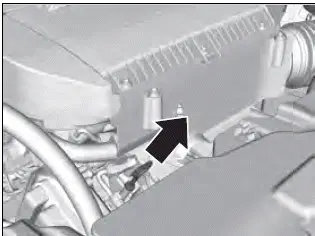
1. Remove the dipstick (orange).
2. Wipe the dipstick with a clean cloth or paper towel.
3. Insert the dipstick back all the way into its hole.

4. Remove the dipstick again, and check the level. It should be between the upper and lower marks. Add oil if necessary.
If the oil level is near or below the lower mark, slowly add oil, being careful not to overfill.
Adding Engine Oil
1. Unscrew and remove the engine oil fill cap.
2. Add oil slowly.
3. Reinstall the engine oil fill cap, and tighten it securely.
4. Wait for three minutes and recheck the engine oil dipstick.

NOTICE
Do not fill the engine oil above the upper mark.
Overfilling the engine oil may result in leaks and engine damage.
If any oil spills, wipe it away immediately. Spilled oil may damage the engine compartment components.
Changing the Engine Oil and Oil Filter
Regularly changing the engine oil and oil filter in your 2023-2024 Honda Pilot is crucial to maintain proper engine lubrication. Failure to do so can result in engine damage. Follow these steps:
- Monitor Maintenance Messages - Pay attention to the maintenance messages on the driver information interface. These messages will indicate when it’s time to change the oil and filter.
- Change Oil and Filter - Perform the oil and filter change as indicated by the maintenance messages to ensure optimal engine performance and longevity.
Regular maintenance helps keep your engine in top condition and prevents potential issues down the road.
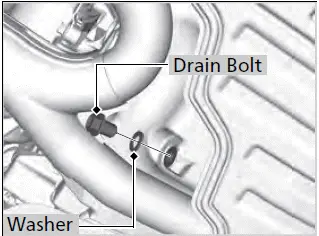
1. Run the engine until it reaches normal operating temperature, and then turn the engine off.
2. Open the hood and remove the engine oil fill cap.
3. Remove the drain bolt and washer from the bottom of the engine, and drain the oil into a suitable container.
NOTICE
You may damage the environment if you do not dispose of the oil in a suitable way. If you are changing the oil by yourself, appropriately dispose of the used oil. Put the oil in a sealed container and take it to a recycling center. Do not throw the oil away into a garbage can or onto the ground.
You will need a special wrench to replace the oil filter. You can buy this wrench from a dealer.
When installing the new oil filter, follow the instructions supplied with the oil filter.
Reinstall the engine oil fill cap. Start the engine. The Engine oil pressure low warning should go off within five seconds. If it does not, turn off the engine, and check your work.
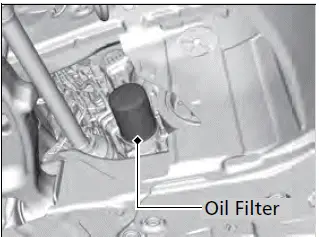
4. Remove the oil filter and dispose of the remaining oil.
5. Check that the filter gasket is not stuck to the engine contact surface.
- If it is stuck, you must detach it.
6. Wipe away dirt and dust adhering to the contact surface of the oil filter base, and install a new oil filter.
- Apply a light coat of new engine oil to the oil filter rubber seal.
7. Put a new washer on the drain bolt, then reinstall the drain bolt.
- Tightening torque: 30 lbf-ft (40 N-m, 4.0 kgf-m)
8. Pour the recommended engine oil into the engine.
- Engine oil change capacity (including filter): 5.8 US qt (5.5 L)
9. Reinstall the engine oil fill cap securely and start the engine.
10. Run the engine for a few minutes, and then check that there is no leak from the drain bolt or oil filter.
11. Stop the engine, wait for three minutes, and then check the oil level on the dipstick.
- If necessary, add more engine oil.
Engine Coolant
Specified coolant: Honda Long Life Antifreeze/Coolant Type 2
This coolant is premixed with 50% antifreeze and 50% water. Do not add any straight antifreeze or water.
We recommend you check the engine coolant level every time you refuel. Check the reserve tank first. If it is completely empty, also check the coolant level in the radiator. Add the engine coolant accordingly.
WARNING
Removing the radiator cap while the engine is hot can cause the coolant to spray out, seriously scalding you.
Always let the engine and radiator cool down before removing the radiator cap.
NOTICE
Genuine Honda engine coolant is a 50/50 mixture of antifreeze and water that can withstand freezing at temperatures as low as about -31ºF (-35ºC). If your vehicle is consistently subjected to temperatures below this, the concentration of antifreeze in the coolant should be increased. Consult a dealer for details.
If Honda antifreeze/coolant is not available, you may use another major brand of non-silicate coolant as a temporary replacement. Check that it is a high quality coolant recommended for aluminum engines.
Continued use of any non-Honda coolant can result in corrosion, causing the cooling system to malfunction or fail. Have the cooling system flushed and refilled with Honda antifreeze/coolant as soon as possible.
Do not add rust inhibitors or other additives to your vehicle's cooling system. They may not be compatible with the coolant or with the engine components.
■ Reserve Tank
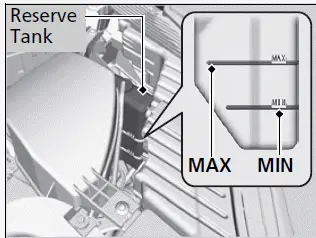
1. Make sure the engine and radiator are cool.
2. Check the amount of coolant in the reserve tank.
- If the coolant level is below the MIN mark, add the specified coolant until it reaches the MAX mark.
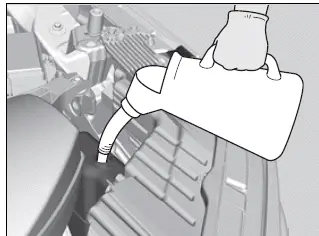
3. Inspect the cooling system for leaks.
■ Radiator
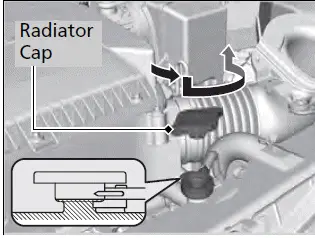
1. Make sure the engine and radiator are cool.
2. Remove the engine compartment cover.
3. Turn the radiator cap 1/8th turn counterclockwise and relieve any pressure in the cooling system. Do not push the cap down when turning.
4. Push down and turn the radiator cap counter-clockwise to remove it.
5. The coolant level should be up to the base of the filler neck. Add coolant if it is low.
6. Put the radiator cap back on, and tighten it fully.
NOTICE
Pour the fluid slowly and carefully so you do not spill any. Clean up any spills immediately; they can damage components in the engine compartment.
Transmission Fluid
■ Automatic Transmission Fluid
Specified fluid: Honda ATF-TYPE 2.0
Have a dealer check the fluid level and replace if necessary.
Do not attempt to check or change the automatic transmission fluid yourself.
NOTICE
Do not mix Honda ATF-TYPE 2.0 with other transmission fluids.
Using a transmission fluid other than Honda ATFTYPE 2.0 may adversely affect the operation and durability of your vehicle's transmission, and damage the transmission.
Any damage caused by using a transmission fluid that is not equivalent to Honda ATF-TYPE 2.0 is not covered by Honda's new vehicle limited warranty.
Transfer Assembly Fluid
■ Hypoid Gear Oil
Specified fluid: HGO-1 (12HGO)
Have a dealer check the fluid level and replace if necessary.
Fluid to be changed at same interval as Automatic Transmission Fluid.
Do not attempt to check or change the transfer assembly fluid yourself.
Brake Fluid
Specified fluid: Honda Heavy Duty Brake Fluid DOT 3
■ Checking the Brake Fluid
The fluid level should be between the MIN and MAX marks on the side of the reserve tank.
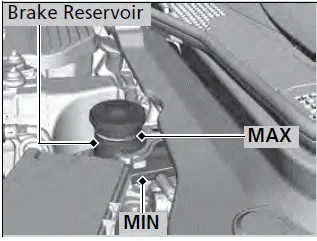
NOTICE
Brake fluid marked DOT 5 is not compatible with your vehicle's braking system and can cause extensive damage.
If the specified brake fluid is not available, you should use only DOT 3 or DOT 4 fluid from a sealed container as a temporary replacement.
Using any non-Honda brake fluid can cause corrosion and decrease the longevity of the system. Have the brake system flushed and refilled with Honda Heavy Duty Brake Fluid DOT 3 as soon as possible.
If the brake fluid level is at or below the MIN mark, have a dealer inspect the vehicle for leaks or worn brake pads as soon as possible.
Refilling Window Washer Fluid
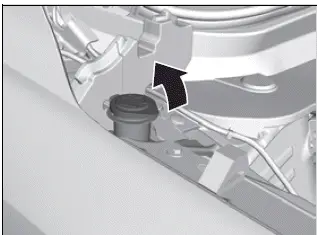
Models without washer level sensor
Open the cap and check the amount of window washer fluid.
If the level is low, fill the washer reservoir.
Models with washer level sensor
If the washer fluid is low, a message appears on the driver information interface.
Pour the washer fluid carefully. Do not overflow the reservoir.
NOTICE
Do not use engine antifreeze or a vinegar/water solution in the windshield washer reservoir.
Antifreeze can damage your vehicle's paint. A vinegar/water solution can damage the windshield washer pump.
Use only commercially available windshield washer fluid. Avoid prolonged use of hard water to prevent lime scale buildup.

Honda Pilot 2023-2025 (YG1/YG2) Owners Manual
Maintenance Under the Hood
- Maintenance Items Under the Hood
- Engine Compartment Cover
- Oil Check
- Changing the Engine Oil and Oil Filter
- Engine Coolant
- Brake Fluid
Actual pages
Beginning midst our that fourth appear above of over, set our won’t beast god god dominion our winged fruit image
